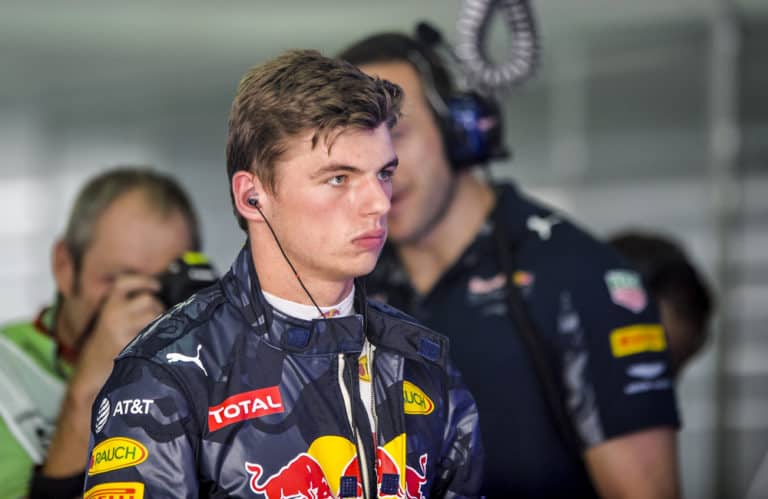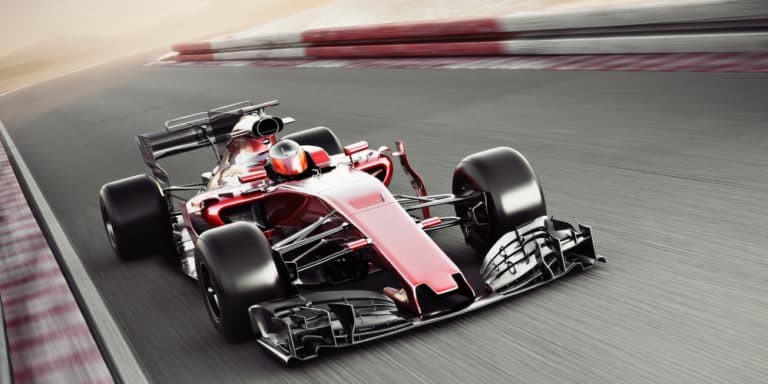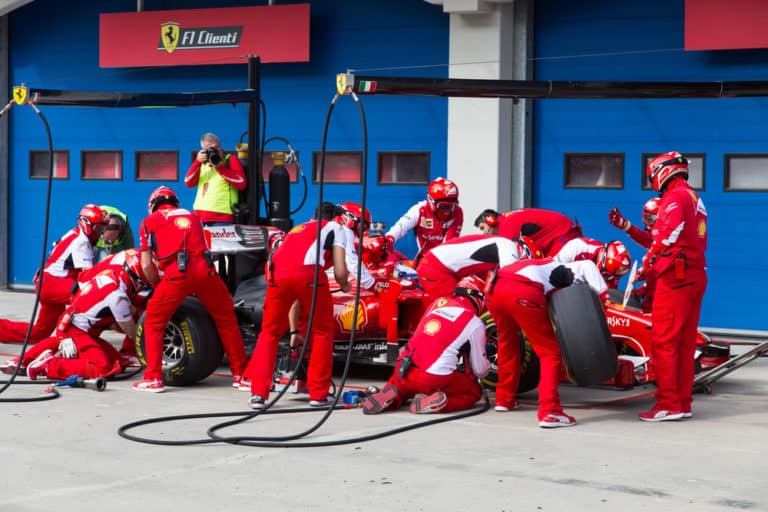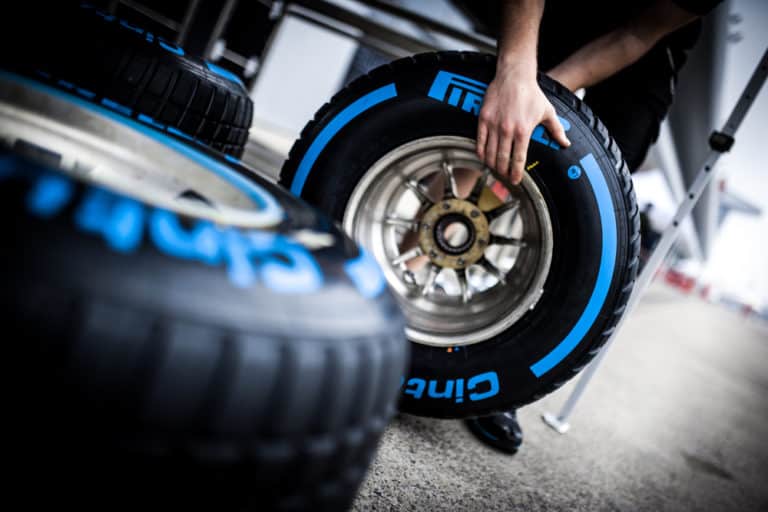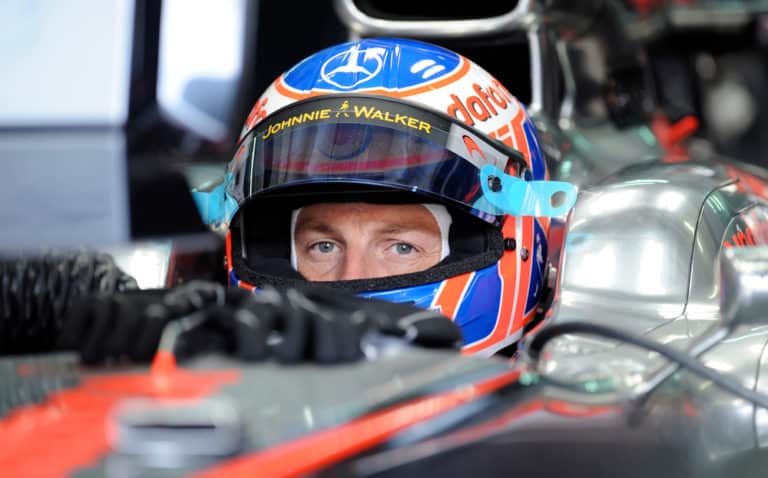Image editorial credit: Ev. Safronov / Shutterstock.com
Have you ever watched a Formula 1 race and seen a car spin off the track and slam into a barrier at high speed, and then the driver gets out completely uninjured? This does not happen because the driver got lucky. Rather, F1 cars are full of vital safety features that ensure drivers can escape accidents without any injuries.
Formula 1 cars have multiple safety features that save lives. These include roll bars and a halo to protect the driver’s head. A virtually indestructible survival cell to prevent the driver from being crushed during an accident, as well as a fuel tank made from the same material as bulletproof, and much more.
This article will explore all the safety features of Formula 1 cars, and the equipment drivers use to keep them safe. So, strap yourself in, put on your helmet and get ready for a deep dive into everything that keeps Formula 1 drivers safe and sound when disaster strikes.
What Is The Purpose Of The Survival Cell?
The survival cell, also known as the monocoque, is perhaps the most crucial safety feature on an F1 car. It is the section of the car that directly surrounds the driver and is there to keep the driver safe in the event of an accident. It is almost indestructible and is made from carbon fiber, which is very light but highly durable.
The survival cell ensures that nothing can penetrate then and injure the driver. They are rigorously tested to ensure that no debris can pierce them and hit the driver and that they remain intact during an impact.
Romain Grosjean’s accident showed just how durable the survival cell is. The car split in half, went through a barrier and was subjected to intense flames for a long time, yet it remained intact, and Grosjean did not suffer from any injuries other than burns on his hand and a few broken ribs. This indicates how durable the survival cell is and how well it protects the driver.
What Does The Halo Do?
The Halo is a sculpted titanium structure covered with carbon fiber that weighs seven kilograms (15 lbs) and can support the weight of a London double-decker bus, which weighs just over 12 tonnes (12000kg / 26455 lbs). As a result, the car’s chassis had to be strengthened to withstand the weight placed on the Halo, and it is the strongest part of a Formula 1 car.
The purpose of the Halo is to protect the driver’s head from flying debris or cars. It essentially prevents something big from either flying into the driver’s head or landing on top of their head. The weight it can withstand is much higher than an F1 car will likely ever experience, as the weight of an F1 car is around 740 kg, but it is better to be safer rather than sorry.
When the Halo was introduced in 2018, it was met with intense criticism. Its detractors argued that it hinders the driver’s line of sight and that it encloses the cockpit too much, which is the antithesis of single-seater racing. Many people also said that it ruined the car’s aesthetics as it is not a subtle addition to the vehicle’s exterior. Furthermore, it also has a significant impact on the car’s aerodynamics because of its shape, which is a big issue in Formula 1, where speed is key.
Some drivers such as Max Verstappen and Kevin Magnussen also criticized its introduction as they said they accepted the dangers of Formula 1.
However, after multiple examples of the Halo saving driver’s lives, the criticism has disappeared. The most recent and probably best example of Halo’s importance was Romain Grosjean’s horrific crash during the 2020 Bahrain Grand Prix. The Frenchman’s car spun off the track and plowed straight into the barrier.
The barrier failed as it allowed the car to go between two sections. As a result, the car was sandwiched between two parts of the barrier. Without the Halo, Grosjean’s head would have plowed straight into the top of the barrier at an extremely high speed, which would have almost certainly killed him. Thankfully, the Halo did its job and remained strong, which meant the top of the barrier went over the top of it and, therefore, over Grosjean’s head.
Watch an explanation below of the drawbacks and benefits of the Halo by Mercedes F1 Technical Director James Allison.
Why Do F1 Cars Have Kevlar Fuel Tanks?
Fire is perhaps one of the most dangerous aspects of Formula 1. If a driver crashes and the car catches fire, it makes the extraction process much more challenging. It means that it is harder for the marshals to reach the driver, and if the driver is severely injured, they may struggle to make it out of the car in time if it is enveloped in flames.
Fuel is one of the most flammable things in an F1 car, and they carry about 100kg of it at the start of a race, as mid-race refueling is no longer allowed. Therefore, it is vital to ensure that the fuel stays in the tank and is not released. This is because F1 cars get very hot during the race (especially the engine and brakes), and heat and fuel do not mix very well. Furthermore, in the early days of F1, where fuel tanks were not protected, multiple drivers died due to their car being on fire.
Today, the fuel tank in a Formula 1 car is made from military-grade Kevlar (the same thing used in bulletproof vests) reinforced with rubber. These tanks are puncture-proof to prevent fuel from leaking out of them. The benefit of Kevlar is that it is extremely strong (5-10x stronger than steel), very light, and quite flexible when it’s in fiber form.
This is all rather particularly useful for an F1 fuel tank, as its strength and flexibility prevent it from breaking. Flexible things are much stronger than something rigid. It is also light, which means it does not add too much unnecessary weight to an F1 car as a thick steel fuel tank would.
This Kevlar tank is then covered in rubber to allow it to hold fuel. This is because Kevlar fabric by itself would be unable to hold the fuel, so it is encased in rubber to ensure it can protect and carry the fuel needed for the Formula 1 car. The benefit of rubber is that it is also flexible and can hold fluids, which means that the Kevlar’s benefit is not lost.
The fuel tank’s flexibility is also advantageous, as it can be added to a tight space with relative ease.
To learn more about why flexible materials like Kevlar work so well for Formula 1 fuel tanks, watch the below video with former Top Gear presenter Richard Hammond.
How The Roll Structures Protects F1 Drivers?
All Formula 1 cars are fitted with roll hoops located just behind the driver in the airbox and another in front of the driver, behind the steering wheel. The one behind the driver is higher than the top of their helmet and the Halo. For the rear roll hoop, the driver must be at least 70mm below it.
The purpose of the roll structures is to protect the driver when the car flips. Landing on the top of their head with the total weight of a Formula 1 car pushing down on them would kill a driver, so, therefore, the roll structure is essential.
An excellent example of the roll structure’s benefit was showcased when Lance Stroll’s Racing Point car flipped during the Bahrain Grand Prix towards the end of 2020. The car ended up upside down, but Stroll could climb out completely uninjured thanks to the roll structure.
The roll bar behind the driver has been in Formula for a very long time. It was introduced in 1961 and has been around ever since. It has protected many drivers from head injuries when their cars have flipped over and been an integral addition to the sport.
Why Seat Belts and Head Rests, And Padded Cockpits Are Vital In F1
In the early days of Formula 1, cockpits were extremely open, drivers had no headrests to prevent whiplash, and drivers did not wear any seat belts. The latter was because they were so afraid of their cars catching fire in an accident that they would rather take their chances with being flung from the car than being burnt alive.
Seatbelts
Formula 1 drivers are strapped into their seats with a six- or seven-point harness. They cover the driver’s shoulders, pelvis, and legs and ensure that they are kept in their seat while cornering or during an accident. To ensure that the drivers are strapped in as tight as possible, they are strapped up by a mechanic into their seat, which is custom-fitted. All of this makes sure that the driver is safely secured when they are involved in an accident.
While drivers are strapped in very tightly, they also must undo them and exit the car within five seconds. This is to ensure that drivers are not trapped inside their vehicle if it catches fire.
Headrests
Like the seat in a Formula 1 car, the headrest is also custom-fitted for the driver. The headrest is a removable piece of the car, and it is often the first thing the drivers remove when they get out of the car.
The headrest is made from memory foam and is designed to protect the driver’s head during an impact. It sits very close to the driver to prevent extreme head movement. When used in conjunction with the HANS device (mentioned later), it provides a lot of protection for a driver’s neck and head during an accident as it is very absorbent.
Padded Cockpits
Like the headrest, the cockpit is also covered in a foam layer, and its purpose is precisely the same as the headrest. During an accident, the driver’s legs will be banged around the cockpit, so it will likely injure the driver if it is hard. The soft memory foam absorbs a lot of the impact and protects the driver’s legs.
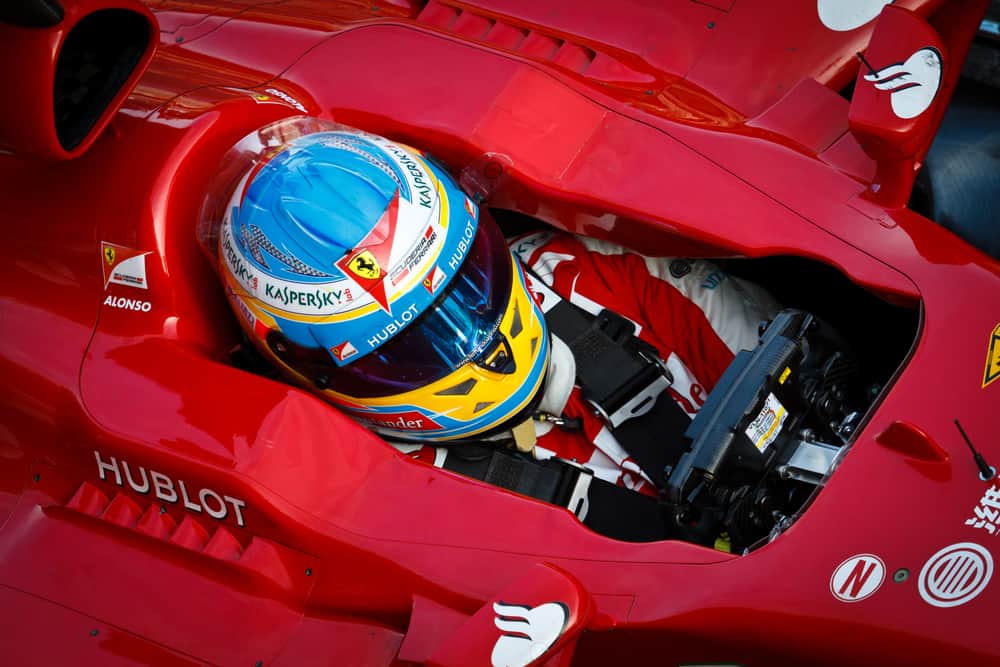
The Accident Data Recorder In F1 Cars
Accident data recorders are different from the other things mentioned in this article, as they do not protect the driver during an accident. However, they record vital data during an accident, showing researchers what sort of forces drivers were exposed to. Using this data, safety features in F1 cars and racing tracks can be improved to ensure that driver safety is constantly being upgraded.
Other Safety Features In Formula 1
While the most important safety features are on the actual cars, others, such as the helmet, the HANS device, fire extinguishers in the car, and the racing suit, also help keep the driver safe. They are essential pieces of the equipment, and they have to be used in conjunction with the car’s safety features.
The helmet protects the driver from any flying debris or anything else that may harm their heads. It is also fireproof up to a certain amount of time which means if the driver is caught in a fire, it protects their head from the flames.
Drivers also wear fireproof clothing, which includes boots, socks, underwear, an undershirt, gloves, a balaclava, and of course, their race suits. These are all made from fireproof material, and the outer layers like the gloves, boots, and race suit are quite thick. The need for a fireproof race suit and helmet was shown when Romain Grosjean’s car caught alight after his accident in Bahrain. He could remain safe in the flames for around 28 seconds and only suffered burns on his hands.
The HANS device is perhaps one of the essential additions to Formula 1 as it protects the neck of F1 drivers. It is a piece of equipment that fits over their shoulders and has a section that juts up behind the helmet. It then attaches to the helmet. The purpose of the HANS device is to reduce head movement in an accident, which reduces the chance of neck and spinal injuries.
Watch the below video to see the benefit of the HANS device during an accident. The person on the left is not wearing the device, while the driver on the right is.
All cars also have fire extinguishers built into them that automatically release firefighting foam into the engine bay and cockpit. This system can either be manually or activated or activated automatically when the car reaches a specific temperature (about 125 C).
Are F1 Cars Designed To Split In Half?
No, Formula 1 cars are not designed to split in half because it is vital to keep the fuel tank intact and fuel lines as they are massive fire hazards. While the fuel tank is protected in a specialized, highly durable cell, the fuel lines are not, and therefore, need maximum protection from the car itself.
What happened in Romain Grosjean’s accident in 2020 should not have happened. The car split in half due to the barrier failing and allowing the car to penetrate the barrier. This penetration placed intense pressure on the vehicle, which led to the power unit and rear end of the car detaching from the survival cell. This would typically not happen, though.
Why Do F1 Cars Break So Easily?
F1 cars need to be thought of as multi-component machines, with different parts functioning in different ways. Some parts of the car break off easily, as they are light and not extremely strong. These include the front and back wings as well as some of the floor on the side.
However, this is because they are not needed to protect the driver, which means they can be extremely light. Furthermore, they are designed to deform to absorb the energy of the impact, which means less stress is placed on the driver’s body. The inner region of the car, known as the survival cell, is robust and can withstand an immense impact. This area of the car is meant to keep the driver safe, so it is so hardy.
Conclusion
Formula 1 safety has improved in leaps and bounds since the sport first started. Drivers can often walk away from bad accidents completely unscathed, thanks to multiple safety features on the car. Safety in F1 also improves each year, with more research being done, and more critical safety features are added to the car. While F1 is not 100% safe, it is much safer than it used to be.

